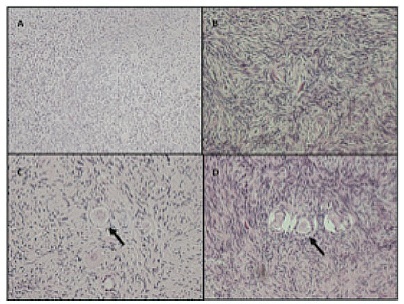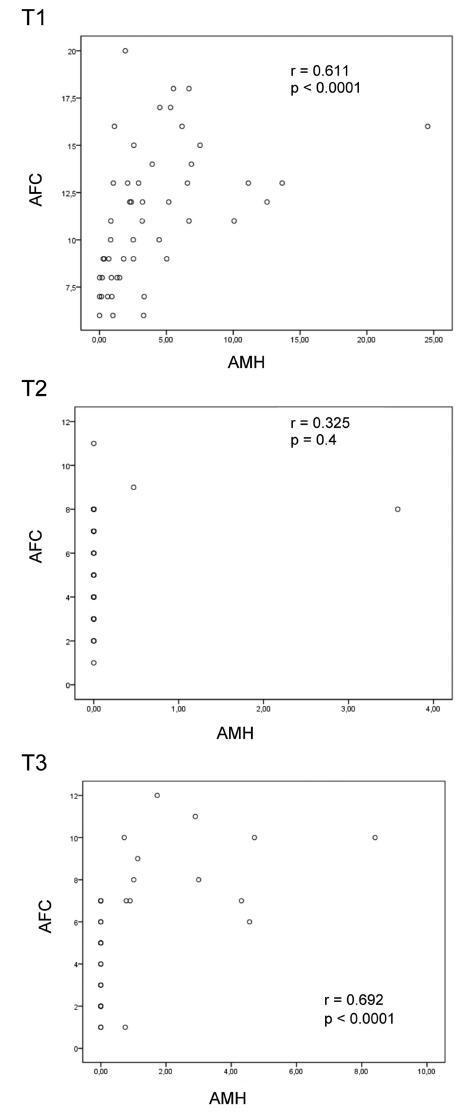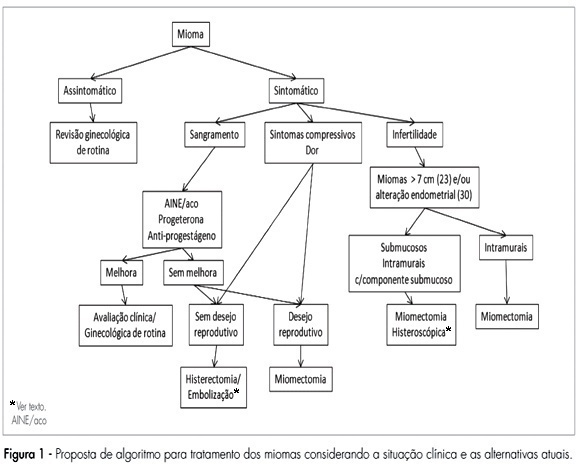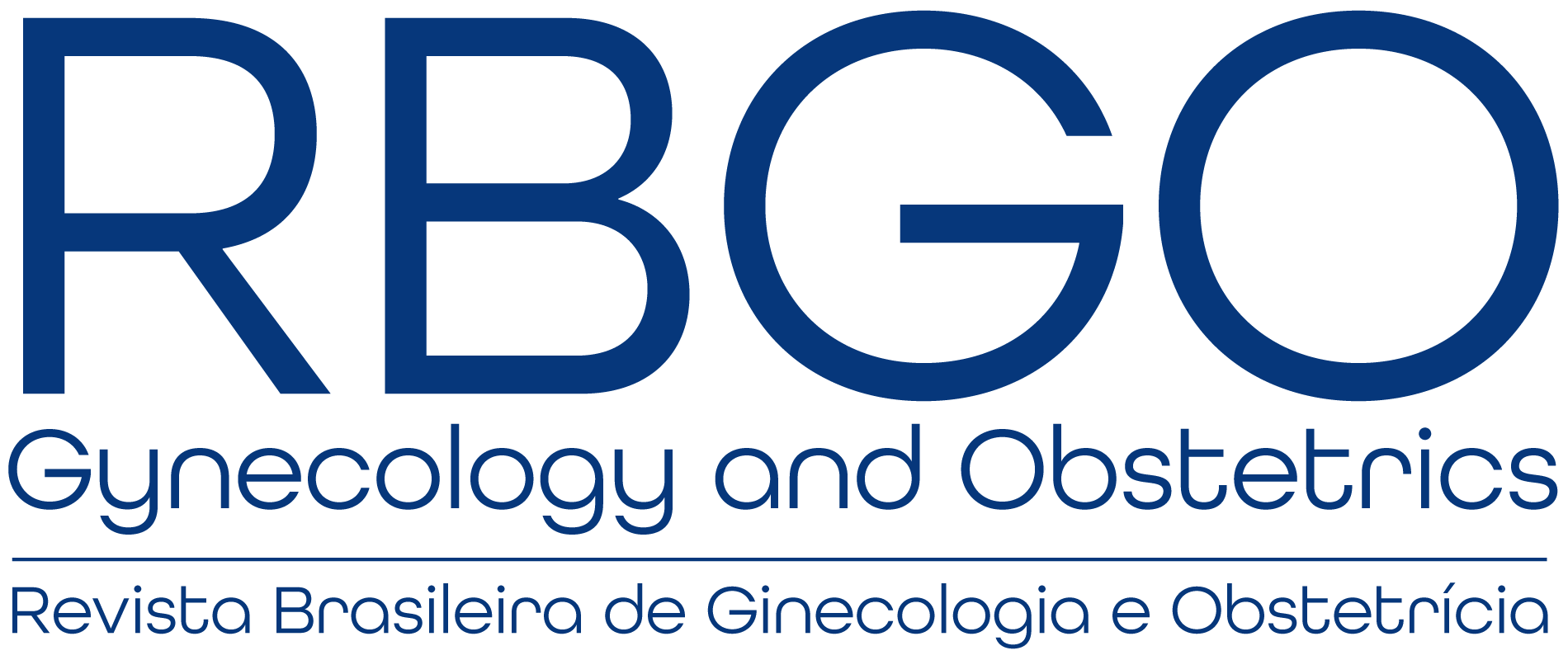You searched for:"Helena von Eye Corleta"
We found (10) results for your search.-
Original Article
Gender affirming hormone therapy and transgender women fertility: Histologic predictors of germ cell presence
Rev Bras Ginecol Obstet. 2024;46:e-rbgo33
Summary
Original ArticleGender affirming hormone therapy and transgender women fertility: Histologic predictors of germ cell presence
Rev Bras Ginecol Obstet. 2024;46:e-rbgo33
Views173Abstract
Objective:
Evaluate histological changes in testicular parameters after hormone treatment in transgender women.
Methods:
Cross-section study with patients who underwent gonadectomy at Hospital de Clínicas de Porto Alegre from 2011 to 2019. Hormone treatment type, route of administration, age at initiation and duration were recorded. Atrophy parameters were observed: testicular volume, tubular diameter, basal membrane length, presence of spermatogonia and spermatids (diploid and haploid spermatozoid precursors).
Results:
Eighty-six patients were included. Duration of hormone treatment is associated with testicular atrophy and spermatogenesis arrest. Other characteristics of hormone treatment such as age of initiation, route of administration and type of treatment were not associated with testicular histological changes. Testicular volume may predict spermatogenesis arrest. Basal membrane length and tubular diameter ratio is an interesting predictor of germ cell presence.
Conclusion:
Cross-sex hormone treatment affects testicular germ cell presence. Basal membrane length and tubular diameter ratio reduces inter variability of measurements and better exemplify how atrophic seminiferous tubules are. Fertility preservation should be addressed by healthcare providers in order to recognize gender affirming treatment impact on transgender health.
Key-words fertilityfertility preservationGonadal steroid hormonesHormone treatmentSpermatogenesisTransgender personsTransgender womenSee more -
Review Article
Timing of semen cryopreservation: before or after processing?
Rev Bras Ginecol Obstet. 2024;46:e-rbgo36
Summary
Review ArticleTiming of semen cryopreservation: before or after processing?
Rev Bras Ginecol Obstet. 2024;46:e-rbgo36
Views158Abstract
Objective:
Seminal cryopreservation causes significant damage to the sperm; therefore, different methods of cryopreservation have been studied. The aim of the study was to compare the effects of density gradient processing and washing/centrifugation with seminal plasma removal for cryopreservation in semen parameters.
Methods:
Seminal samples of 26 normozoospermic patients were divided into 3 parts: with seminal plasma; after washing/centrifugation; and after selection through density gradient. The samples were cryopreserved for at least two weeks. Motility, sperm count, morphology and viability were evaluated before cryopreservation and after thawing.
Results:
Density gradient processing selected motile and viable sperm with normal morphology in fresh samples (p<0.05). Cryopreservation negatively affected all sperm parameters regardless of the processing performed, and even if the sperm recovery was lower in the density gradient after the thawing, progressive motility, total motility, viability and morphology remained higher (p<0.05).
Conclusion:
Cryopreservation significantly compromises sperm parameters (motility, morphology, viability). In normozoospermic patients, the density gradients select better quality spermatozoa compared to other processing methods; this benefit was kept after thawing.
Key-words CentrifugationcryopreservationDensity gradientSemenSeminal plasmaSperm countSperm washSpermatozoaSee more -
Short Communication
Medical Residents, the Group and the Formation of Professional Identity During the COVID-19 Pandemic
Rev Bras Ginecol Obstet. 2022;44(8):797-801
Summary
Short CommunicationMedical Residents, the Group and the Formation of Professional Identity During the COVID-19 Pandemic
Rev Bras Ginecol Obstet. 2022;44(8):797-801
Views4See moreAbstract
Residency is still considered the gold standard for quality medical training, and acquiring a professional identity as a specialist is one of its central elements. Residents obtain this identity through both the educational environment and direct interaction with peers and supervisors. However, modifications in health care and educational routines during the recent coronavirus disease 2019 (COVID-19) pandemic have significantly impaired these channels. This study is part of a qualitative research project to analyze professional identity formation in a medical residency program in obstetrics and gynecology at a public hospital in southern Brazil. The authors conducted 28 semi-structured interviews with medical residents and preceptors, as well as a focus group with the residents, which was recorded, transcribed, and analyzed in an effort to construct major analytical categories. Restricted movement and physical contact have forced the use of alternative means of interpersonal interaction, such as communication through social media or instant messaging applications. This has also affected educational activities, such as morning rounds, lectures, and seminars. These changes represent a significant impact, especially in Brazil, where physical proximity is an important cultural feature, even in the work and school environments. We speculate that this new type of virtual interaction will also affect the formation of professional identity among obstetrician-gynecologists. These findings suggest that medical residency programs should be attentive to changes in resident training to ensure that the specialist profile and the expected skills, which are consolidated over many years, are not lost.
-
Original Article
Ovarian Tissue Culture to Preserve Fertility in Transgender Male Patients after Hormonal Treatment
Rev Bras Ginecol Obstet. 2022;44(3):251-257
Summary
Original ArticleOvarian Tissue Culture to Preserve Fertility in Transgender Male Patients after Hormonal Treatment
Rev Bras Ginecol Obstet. 2022;44(3):251-257
Views1Abstract
Objective
To evaluate the reproductive and histological characteristics of fresh cultured ovarian tissue from transgender male patients.
Methods
An in vitro pilot study in which samples were collected during sex reassignment surgery for transgender male patients. The ovarian cortex was cut into fragments of 2 mm, 3mm, and 4 mm, and placed in a 96-well plate suitable for cultivation at days 0, 2, 4, 6, and 8, when the histology was analyzed.
Results
Stromal hyperplasia was observed in all samples, and it was not associated with the obtainment of primordial or primary follicles. Peripheral reduction in cell count was also a recurrent finding. Primordial and primary follicles were identified with a heterogeneous pattern in fragments from the same patient and from different patients, and follicles in more advanced stages of development (secondary and antral) were not found. There was an association between the diameter of the ovarian fragments and the identification of primary follicles (p=0.036). The number of days in culture was associated with histological signs of tissue damaging in the fragments (p=0.002). The total number of follicles identified in the samples with 2mm in diameter was significantly lower than in those that measured 4mm in diameter (p=0.031).
Conclusion
A diameter of 4mm is suitable for ovarian tissue culture with the benefit of ease of handling. Even after prolonged exposure to testosterone, the ovarian fragments presented primordial and primary follicles, maintaining viability throughout the days they were exposed to the culture. Freezing the ovarian cortex of transgender patients who will undergo surgery for gender reassignment would be an interesting option, in the future, for the preservation of fertility.
Key-words fertility preservationgender reassignment surgeryovarian reserveovarytissue culture techniquesSee more
-
Original Article
Contribution of Ultra-processed Food to the Daily Food Intake of HIV-positive and HIV-Negative Women during Pregnancy
Rev Bras Ginecol Obstet. 2019;41(10):588-596
Summary
Original ArticleContribution of Ultra-processed Food to the Daily Food Intake of HIV-positive and HIV-Negative Women during Pregnancy
Rev Bras Ginecol Obstet. 2019;41(10):588-596
Views2See moreAbstract
Objective
To assess the daily dietary intake and energy contribution of ultraprocessed foods among women who are positive and negative for the human immunodeficiency virus (HIV) during pregnancy.
Methods
This case-control study included 77 HIV-positive and 79 HIV-negative puerperal women between 2015 and 2016. The socioeconomic and maternal demographic data were assessed, and a food frequency questionnaire (FFQ) adapted for pregnant women was applied. The Fisher exact test and the Mann-Whitney test were applied to detect differences between the groups. Linear regression was used to assess the associations between the intake of ultra-processed food and energy, macro- and micronutrients, with values of p < 0.05 considered significant.
Results
The HIV-positive group was older (p< 0.001) and had lower income (p= 0.016) and level of schooling (p< 0.001) than the HIV-negative group. Both groups presented similar average food intake: 4,082.99 Kcal/day and 4,369.24 Kcal/day for the HIV-positive and HIV-negative women respectively (p= 0.258).The HIV-positive group consumed less protein (p= 0.048), carbohydrates (p= 0.028) and calcium(p= 0.001), andmore total fats (p= 0.003). Ultra-processed foods accounted for 39.80% and 40.10% of the HIV-positive and HIV-negative groups’ caloric intake respectively (p= 0.893). The intake of these foods was associated with a higher consumption of carbohydrates (p < 0.001), trans fat (p= 0.013) and sodium (p< 0.001), as well as lower protein (p < 0.001) and fiber intake (p= 0.022).
Conclusion
These findings demonstrate that the energy consumption and ultraprocessed food intake were similar in both groups, which reinforces the trend toward a high intake of ultra-processed food in the general population. The intake of ultraprocessed food was positively associated with the consumption of carbohydrates, trans fat and sodium, and negatively associated with the consumption of protein and fiber.
-
Original Article
Antral Follicles Count and Anti-Müllerian Hormone Levels after Gonadotoxic Chemotherapy in Patients with Breast Cancer: Cohort Study
Rev Bras Ginecol Obstet. 2017;39(4):162-168
Summary
Original ArticleAntral Follicles Count and Anti-Müllerian Hormone Levels after Gonadotoxic Chemotherapy in Patients with Breast Cancer: Cohort Study
Rev Bras Ginecol Obstet. 2017;39(4):162-168
Views1Abstract
Aim
To assess ovarian reserve (OVR) by means of follicle-stimulating hormone (FSH), anti-Müllerian hormone (AMH), and antral follicle count (AFC) measurement in eumenorrheic women with breast cancer, exposed to gonadotoxic chemotherapy.
Method
Fifty-two women (35.3 ± 3.8 years old) with breast cancer and undergoing cyclophosphamide-containing chemotherapy were enrolled. The assessment was performed before chemotherapy (T1) and after 2 (T2) and 6 months (T3).
Results
Six months after chemotherapy, the prevalence of regular cycles was 60%. Anti-Müllerian hormone decreased down to undetectable levels at T2 and T3 (T1: 2.53 [1.00–5.31]; T2 < 0.08; T3: < 0.08 [< 0.08–1.07] ng/mL), (p< 0.0001). Antral follicle count was 11 [8.0–13.5] follicles at T1 and lower at T2 (5.50 [3.75–8.0] and T3 (5.0 [2.5–7.0]) (p< 0.0001). In patients who remained with regular cycles during chemotherapy or resumed normal menses, FSH and estradiol levels remained unchanged.
Conclusion
Anti-Müllerian hormone and AFC are useful as markers of OVR decline in women exposed to chemotherapy. Follicle-stimulating hormone is only adequate in women who become amenorrheic.
Key-words anovulationanti-Müllerian hormoneantral follicle countchemotherapy-induced amenorrheaovarian reserveSee more
-
Original Article
Obesity as a risk factor to Burch surgery failure
Rev Bras Ginecol Obstet. 2009;31(4):182-188
Summary
Original ArticleObesity as a risk factor to Burch surgery failure
Rev Bras Ginecol Obstet. 2009;31(4):182-188
DOI 10.1590/S0100-72032009000400005
Views2PURPOSE: to observe the impact of obesity and other risk factors on the rate of failure in patients submitted to Burch’s surgery for the treatment of urinary incontinence. METHODS: cases study of patients submitted to Burch’s surgery, from 1992 to 2003. Patients were evaluated at the second post-surgery appointment (average 66 days) and after one-year follow-up, and classified in two groups: Continent and Non-continent. Variables analyzed were: age, parity, body mass index (BMI), menopause duration, duration of hormonal therapy, urodynamic evaluation, history of urinary tract infection, previous urinary incontinence surgery, diabetes, cystocele and uterine prolapse, time spent in hospital, necessity of self-probing, post-surgical spontaneous micturition, and surgical wound. Data were analyzed with the Statistical Package for Social Sciences 14.0 statistical package. For the comparison of continuous variables, Student’s t-test or Mann-Whitney test were used, and Fisher exact and χ2 tests, for the categorical variables (p<0.05). RESULTS: at the second post-surgical evaluation, there was no significant difference between the two groups, concerning the variables analyzed. After one-year follow-up, from a total of 97 patients, 81 were continent and 16, non-continent, BMI and height being different between the groups. In the continent group, average BMI was 27.1 and height, 1.57 m, and, among the non-continent, 30.8 (p=0.02) and 1.52 m (p=0.01). The BMI>30 Odds Ratio was 3.7 (CI95%=1.2-11.5). CONCLUSIONS: obesity has shown to be an important risk factor for the surgery failure in the first follow-up year. Results show that patients with BMI>30 have 3.7 times more chance of being non-continent one-year after Burch’s surgery than non-obese patients.
Key-words Femaleobesitypostoperative complicationsUrinary incontinence, stressUrological surgical proceduresSee more -
Review Article
Current treatment of leiomyomas
Rev Bras Ginecol Obstet. 2007;29(6):324-328
Summary
Review ArticleCurrent treatment of leiomyomas
Rev Bras Ginecol Obstet. 2007;29(6):324-328
DOI 10.1590/S0100-72032007000600008
Views3Leiomyomas are benign tumors. They appear in the myometrium and present a variable amount of fibrous conjunctive tissue. About 75% of the cases are not symptomatic and are usually found during abdominal, bimanual pelvic examination or during ultrasonography. The symptoms are directly related to the size, number and localization of the myomas. In the present review, the current clinical therapeutic procedures (oral anti-conceptive drugs, progestins and anti-progestins, analogues of the gonadothrophins’ releasing hormone (GnRH), and non-steroid anti-inflammatory drugs), and also the surgical procedures (hysterectomy, myomectomy, embolization) are presented for the treatment of leiomyomas.
Key-words Embolization, therapeuticGonadotropin-releasing, hormonehysterectomyleiomyomamyomaReceptors, progesteroneSee more
Search
Search in:
Tag Cloud
breast (42) breast cancer (42) breast neoplasms (95) Cesarean section (72) endometriosis (66) infertility (56) Maternal mortality (43) menopause (82) obesity (58) postpartum period (40) pregnancy (225) Pregnancy complications (99) Prenatal care (68) prenatal diagnosis (50) Prevalence (41) Quality of life (51) risk factors (94) ultrasonography (79) urinary incontinence (40) women's health (48)


